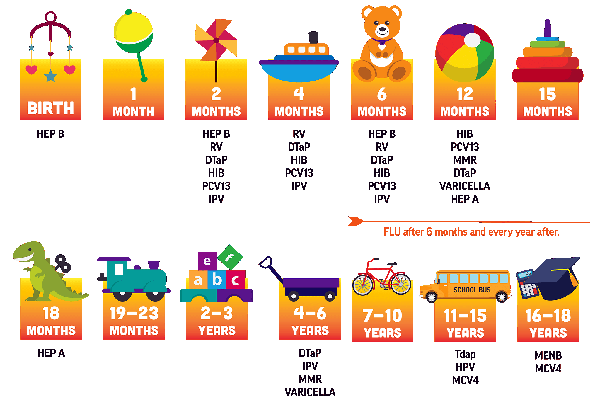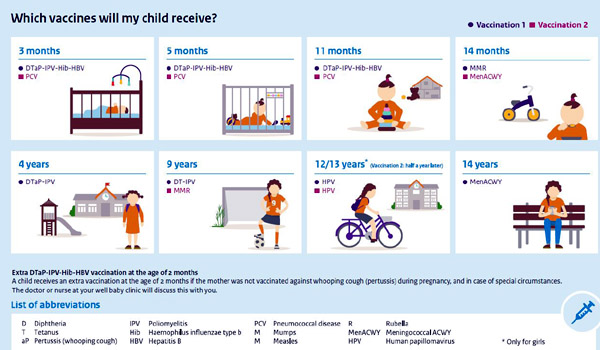Immunization is an artificial method to provide immunity against antigens through vaccines. Vaccines will restore the body’s immune response, resulting in antibodies that fight against diseases if the body experiences the same problem. Every country has its own National Immunization Schedule Programme.

Immunization is a process of making a person immune or resistant to infectious diseases by taking vaccines that stimulate the body’s immune system. This process will be successful when all the people of the nation cooperate.
Contents
National immunization schedule or Vaccination
Immunization is one of the global health and development success stories which saves millions of lives every year. Vaccines build natural defence protection in the body and work to reduce the risk of getting diseases.
Implementing National, Immunization prevents 2-3 million deaths every year. The diseases diphtheria, tetanus, pertussis, influenza, and measles are prevented.
Vaccines are also critical to prevent and controlling infectious disease outbreaks. This immunization will support global health security and be a vital tool in the battle against antimicrobial resistance.
Effects of Vaccination
Sometimes Vaccination also has some side effects as pain at the injection spot and mild fever.
DPT (Diphtheria, Pertussis, Tetanus) Vaccine will show some side effects; for measles, vaccine rashes may develop after use. Taking some vaccines may also cause allergies in babies.
In some cases, the baby may get a high fever and even lose consciousness after Vaccination. In such cases, the baby is taken to the doctor immediately.
Consulting doctors and taking treatment correctly will result in complete recovery from fever.
National Immunization Schedule Chart 2022
Below is the latest National Immunization Schedule 2020 chart by the government of India.
| Age | Vaccination |
| Birth | Bacillus Calmette Guerin (BCG), Oral Polio Vaccine (OPV)-0 dose, Hepatitis B birth dose |
| 6 Weeks | OPV-1, Pentavalent-1, Rotavirus Vaccine (RVV)-1, Fractional dose of Inactivated Polio Vaccine (IPV)-1, Pneumococcal Conjugate Vaccine (PCV) -1 |
| Ten weeks | OPV-2, Pentavalent-2, RVV-2 |
| 14 weeks | OPV-3, Pentavalent-3, fIPV-2, RVV-3, PCV-2 |
| 9-12 months | Measles & Rubella (MR)-1, JE-1, PCV-Booster |
| 16-24 months | MR-2, JE-2, Diphtheria, Pertussis & Tetanus (DPT)-Booster-1, OPV – Booster |
| 5-6 years | DPT-Booster-2 |
| Ten years | Tetanus & adult Diphtheria (Td) |
| 16 years | Td |
| Pregnant Mother | Td-1, Td-2 or Td-Booster |

National Immunization Schedule Table for Pregnant Women, Infants & Children
For Pregnant Women
| Vaccine | When to give | Dose | Route | Site |
| Tetanus & adult Diphtheria (Td)- 1 | Early in pregnancy | 0.5 ml | Intra-muscular | Upper Arm |
| Td-2 | Four weeks after Td- 1 | 0.5 ml | Intra-muscular | Upper Arm |
| Td- Booster | If received 2 TT/Td doses in pregnancy within the last three years* | 0.5 ml | Intra-muscular | Upper Arm |
National Immunization Schedule For Infants
| Vaccine | When to give | Dose | Route | Site |
| Bacillus Calmette Guerin (BCG) | At birth or as early as possible till one year of age. | 0.1ml (0.05ml until one month age) | Intra-dermal | Left Upper Arm |
| Hepatitis B – Birth Dose | At birth or as early as possible within 24 hours | 0.5 ml | Intra-muscular | Antero-lateral side of the mid-thigh |
| Oral Polio Vaccine (OPV)-0 | At birth or as early as possible within the first 15 days | Two drops | Oral | Oral |
| OPV 1, 2 & 3 | At six weeks, ten weeks & 14 weeks (OPV can be given till five years of age) | Two drops | Oral | Oral |
| Pentavalent 1, 2 & 3 | At six weeks, ten weeks & 14 weeks (can be given till one year of age) | 0.5 ml | Intra-muscular | Antero-lateral side of the mid-thigh |
| Pneumococcal Conjugate Vaccine(PCV) | Two primary doses at 6 and 14 weeks, followed by a Booster dose at 9-12 months | 0.5 ml | Intra-muscular | Antero-lateral side of the mid-thigh |
| Rotavirus (RVV) | At six weeks, ten weeks & 14 weeks (can be given till one year of age) | Five drops (liquid vaccine) 2.5 ml (lyophilized vaccine) | Oral | Oral |
| Inactivated Polio Vaccine (IPV) | Two fractional doses at 6 and 14 weeks of age | 0.1 ml | Intradermal two fractional dose | Intra-dermal: Right upper arm |
| Measles-Rubella (MR) 1st dose | Nine completed months-12 months. (Measles can be given till five years of age) | 0.5 ml | Sub-cutaneous | Right upper arm |
| Japanese Encephalitis (JE) – 1 | Nine completed months-12 months. | 0.5 ml | Sub-cutaneous (Live attenuated vaccine), Intramuscular(Killed vaccine) | Left upper Arm (Live attenuated vaccine) Anterolateral aspect of mid-thigh (Killed vaccine) |
| Vitamin A (1st dose) | At nine completed months with measles-Rubella | 1 ml ( 1 lakh IU) | Oral | Oral |
National Immunization Schedule For Children
| Vaccine | When to give | Dose | Route | Site |
| Diphtheria, Pertussis & Tetanus (DPT) booster-1 | 16-24 months | 0.5 ml | Intra-muscular | Antero-lateral side of mid-thigh |
| MR 2nd dose | 16-24 months | 0.5 ml | Sub-cutaneous | Right upper arm |
| OPV Booster | 16-24 months | Two drops | Oral | Oral |
| JE-2 | 16-24 months | 0.5 ml | Sub-cutaneous (Live attenuated vaccine), Intramuscular(Killed vaccine) | Left upper Arm (Live attenuated vaccine) Anterolateral aspect of mid-thigh (Killed vaccine) |
| Vitamin A (2nd to 9th dose) | 16-18 months. Then one dose every six months Up to the age of 5 years. | 2 ml (2 lakh IU) | Oral | Oral |
| DPT Booster-2 | 5-6 years | 0.5 ml. | Intra-muscular | Upper Arm |
| Td | Ten years & 16 years | 0.5 ml | Intra-muscular | Upper Arm |
Note
- JE Vaccine is in select endemic districts after the campaign.
- The 2nd to 9th doses of Vitamin A can be given to children1-5 years old during biannual rounds in collaboration with ICDS.
- PCV is given in selected states/districts: Bihar, Himachal Pradesh, Madhya Pradesh, Rajasthan & Uttar Pradesh (selected districts), and in Haryana as a state initiative
WHO – Immunization and Vaccines
- World Health Organization is working with countries to improve global vaccination coverage under the “global vaccine action plan 2011-2020.” WHO also
- It helps all countries to give a commitment to immunization as a priority. World Health Organisation is working with the countries to set targets and plans and allocate sufficient financial and human resources.
- The organization also supports individuals and communities in understanding the benefits of vaccine and immunization demands as every country’s rights and responsibility.
- They are developing plans accordingly and supplying materials to ensure the vaccines reach every person.
- Vaccines strengthen the immunization system to serve as a platform for delivering health interventions.
- It is also developing targeted research and innovations for new and improved vaccines.
FAQs
What is National Immunization Schedule?
The national immunization schedule is a series of Vaccination that includes the timing and doses recommended and sometimes necessary.
This immunization schedule is also known as the vaccination schedule. Vaccines require multiple doses for maximum effectiveness to produce a sufficient immune response and boost the faded response.

